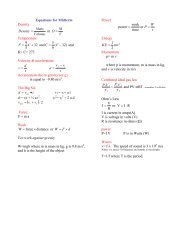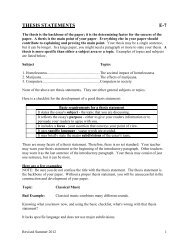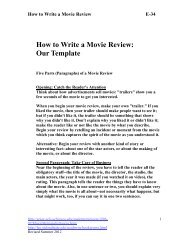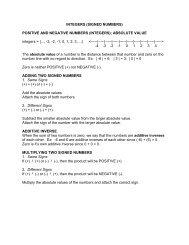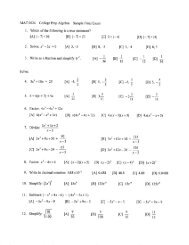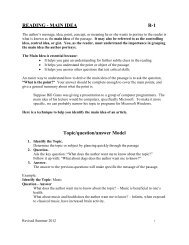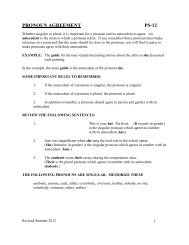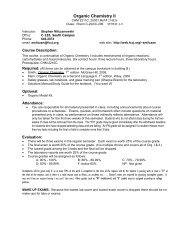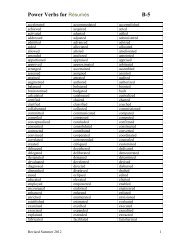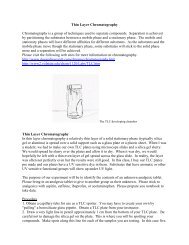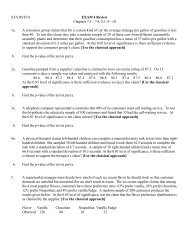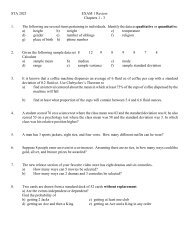Saponification: The preparation of Soap
Saponification: The preparation of Soap
Saponification: The preparation of Soap
- No tags were found...
You also want an ePaper? Increase the reach of your titles
YUMPU automatically turns print PDFs into web optimized ePapers that Google loves.
Synthetic detergents differ from soaps in that they are salts o long-chain alkyl sulfuricacids or alkylbenzenesulfonic acids, rather than carboxylic acids.OCH 3 (CH 2 ) 10 -CH 2 -OSOHOCH 3CH 3 (CH 2 ) 10 -CH-OS-OHOFigure 2 Alkyl sulfuric acid (left) and alkylbenzenesulfonic acid (right)OCH 3 (CH 2 ) 10 -CH 2 -OSO - Na +OCH 3CH 3 (CH 2 ) 10 -CH-OS-O - Na +OFigure 3 Alkyl sulfate salt (detergent) at left. Alkylbenzenesulfonate salt (detergent) at right<strong>The</strong> function <strong>of</strong> soaps and detergents is to remove grease and dirt by emulsifying thegrease (bringing it into suspension). Dirt adheres to clothing and to skin primarily bybeing “glued” to these surfaces with a thin film <strong>of</strong> oil or grease; the oil (lipid) on the skinis generally secreted during perspiration. <strong>The</strong> soap or detergent removes the oil film andthe dirt can be washed away.How do soaps and detergents “dissolve” non-polar substances such as fats, oils, andgreases? Molecules <strong>of</strong> soaps and detergents contain a non-polar (hydrophobic)hydrocarbon end, and a polar (hydrophilic) end that is usually ionic. <strong>The</strong> non-polar ends<strong>of</strong> the molecule surround the tiny oil droplets and are partially dissolved in them (likedissolves like). <strong>The</strong> polar ends <strong>of</strong> the molecules, which are extremely soluble in water,solubilize or emulsify the entire droplet.<strong>Soap</strong>s do not work well in hard water because the divalent cations <strong>of</strong> dissolved minerals(Ca +2 , Mg +2 , and Fe +2 ) form precipitates with the carboxylate (fatty acid) anions <strong>of</strong>soaps. Consequently, a scum <strong>of</strong> calcium stearate (and other salts) is found as a ring in thebathtub or as a dingy film on clothes, hair, and skin.CH 3 (CH 2 ) 16OC O - Ca +2 C (CH 2 ) 16 CH 3Figure 4 Calcium stearate (a scum in hard water)On the other hand, the alkyl sulfate and alkyl sulfonate anions <strong>of</strong> detergents do not formprecipitates with these cations, so they are quite effective in hard water.In today’s experiment you will prepare a potassium soap by the saponification <strong>of</strong> a fatwith potassium hydroxide. You will use the potassium soap to make a sodium soap and
to obtain a mixture <strong>of</strong> fatty acids. You will also compare some <strong>of</strong> the properties <strong>of</strong> soapsand detergents.Hydrophilic endHydrophobic endFigure 5 A soap micelle. <strong>Soap</strong> molecules surround the oil droplet. <strong>The</strong>ir hydrocarbon (hydrophobic)ends are attracted to the oil, while the hydrophilic ends are left on the exterior. <strong>The</strong> entire micellenow appears to be hydrophilic, and dissolves in water.Procedure:A. <strong>Saponification</strong> <strong>of</strong> a fat; <strong>preparation</strong> <strong>of</strong> a potassium soap.Mass about 1.5 g <strong>of</strong> solid fat (tallow, lard, or shortening) in a large test tube. (It is notnecessary to force the fat to the bottom <strong>of</strong> the test tube, since it will melt and rundown when the test tube is heated.) Add 10 mL <strong>of</strong> a 10% solution <strong>of</strong> KOH in 95%ethyl alcohol. Place the test tube in a 250 mL beaker half-filled with boiling water.Replace any alcohol that evaporates with ethyl alcohol. (Remember that alcohol isflammable)After heating the tube for 15 minutes, test for completeness <strong>of</strong> saponification byadding a few drops <strong>of</strong> the reaction mixture to water. Do you see droplets <strong>of</strong> fat? Ifnot, saponification is complete. If droplets <strong>of</strong> fat are visible, continue to heat the tubefor another 15 minutes and test again.When the saponification <strong>of</strong> the fat is complete, pour the contents <strong>of</strong> the tube into a100 mL beaker. Cautiously evaporate the alcohol until the residue becomes viscousand tacky; do not overheat it or the soap will darken. Now add 30 mL <strong>of</strong> distilledwater and heat the mixture briefly, while stirring it until a solution is obtained. <strong>The</strong>product is a solution <strong>of</strong> potassium soap.B. Properties <strong>of</strong> <strong>Soap</strong>s and Detergents:Test a 1-mL portion <strong>of</strong> your potassium soap solution for sudsing action. Smear some<strong>of</strong> the starting fat on the bottom <strong>of</strong> a watch glass, and determine whether yourpotassium soap solution removes the grease. Perform the same tests with a little <strong>of</strong>your sodium soap added to water.
To 1 mL portions <strong>of</strong> your potassium soap solution in three separate test tubes, add 1mL <strong>of</strong> each <strong>of</strong> the following solutions: Calcium Chloride (0.1%) Magnesium Chloride(0.1%), and Iron(II) Chloride (0.1%). Stir the solutions. Do precipitates form?Repeat this test with a synthetic detergent such as Tide or Dreft. Prepare asolution <strong>of</strong> the detergent by dissolving 0.5 g <strong>of</strong> detergent in 50 mL <strong>of</strong> distilled water.Now mix equal portions (1 mL <strong>of</strong> each) <strong>of</strong> your potassium soap and tap water. Doesa precipitate form? Repeat with the detergent solution.Post-Lab questions:1. What is the difference between a detergent and a soap?2. Why do detergents typically not form soap scum?3. What is a micelle?4. Indicate the polarity differences that occur in a soap molecule? (Draw a picture.)5. What is a saturated fatty acid?6. What is an unsaturated fatty acid? (Are double bonds cis or trans?)7. List the percentages and draw the major fatty acids that make up Butter? Oliveoil?8. Draw a mechanism for the saponification. (Just one acid will be fine.)



